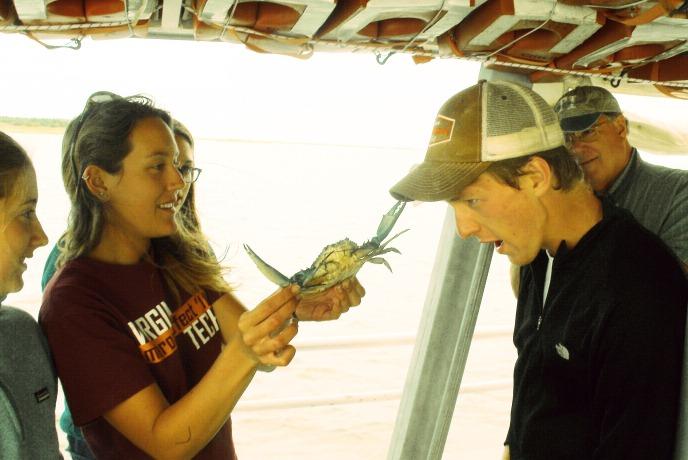Crabbing With Ooker

Students study the Chesapeake Bay’s inhabitants—human and otherwise
by Tony Moore
Port Isobel is a 250-acre island in the Chesapeake Bay, and Ashton Nichols, Walter E. Beach '56 Distinguished Chair in Sustainability Studies; Marcus Key, Joseph Priestley Professor of Natural Philosophy; and Gene Wingert, visiting instructor in biology, have brought 10 of their students here as part of Dickinson's Natural History Sustainability Mosaic.
And they are the only people on the island: The few inhabitants the island ever had headed west to Tangier Island (pop. 450) in the 1920s when rising sea levels encroached. For Nichols, whose chief Mosaic focus is his Writing About Natural History class, the islands of the Chesapeake Bay offer ample opportunities for scientific, historical and nature writing.
The Chesapeake is your classroom
In large part, as Nichols explains, he and the students are standing on the muddy shores of Isobel Island to investigate some of the more theoretical questions about the relationship between humans and the natural world—and to later flesh out those questions from journals they'll keep. For Dylan McNair '14, a biology major, the island-hopping trip is a great place to experience that relationship.
"When we went to Tangier Island, we got to see firsthand the kind of life that the watermen of the Chesapeake live," McNair says. "And the whole time you just knew you were surrounded by everything you had just learned about back at Dickinson."
"Every time we leave the classroom, it's really exciting," Eller Mallchok '15 adds. "Everything we learn in the field, we could learn in the classroom, but we're onsite, seeing it firsthand."
Learning directly from the locals has its benefits as well, as the Dickinson contingent discovered when they invited the mayor of Tangier Island, James "Ooker" Eskridge, to dinner one night. He arrived at Isobel Island at sunset in his boat with 24 soft-shell crabs he had caught that morning.
"And then he had dinner with us and sat for about an hour and answered the students' questions about being the mayor of Tangier, about life on the bay," Nichols says. "For the students, this is the best kind of education they can get."
Preservation efforts
A lot of what they've learned involves preservation efforts surrounding the bay and its marine inhabitants.
"As it turns out, this year has a larger population of crabs in the Chesapeake Bay, probably larger than any time in the last half century," Nichols says, citing the region's strict body of regulations as the reason behind the animals' reinvigoration. As a Marylander, Nichols has been following the bay's status for years, and he knows the history as if it were his own.
"When John Smith arrived here, it's been estimated that there were so many oysters that they could filter the whole bay within a matter of hours or days," he says, noting that oysters are of short supply and no longer commercially viable in the area. "But there are thousands of people who are working to make things better. And there are tens of thousands of people who care about making things better."
Experiencing natural history through contemporary academic themes is what the Mosaic is all about, and that point hasn't been lost on the students. "Going to the Chesapeake put us right in the middle of what we were studying and allowed for a much more holistic approach to learning," McNair says.
For Mallchok, the trip seems to have transcended more than just the classroom: "A couple of us were out walking on the dock at night, looking at the stars, and we were like, 'This is by far the best week of classes I've ever had.' "
Learn more
- The Mosaic climbs a quarry to see how paleontology is done
- A hawk watch is on the agenda in another leg of the Mosaic
Published September 8, 2013